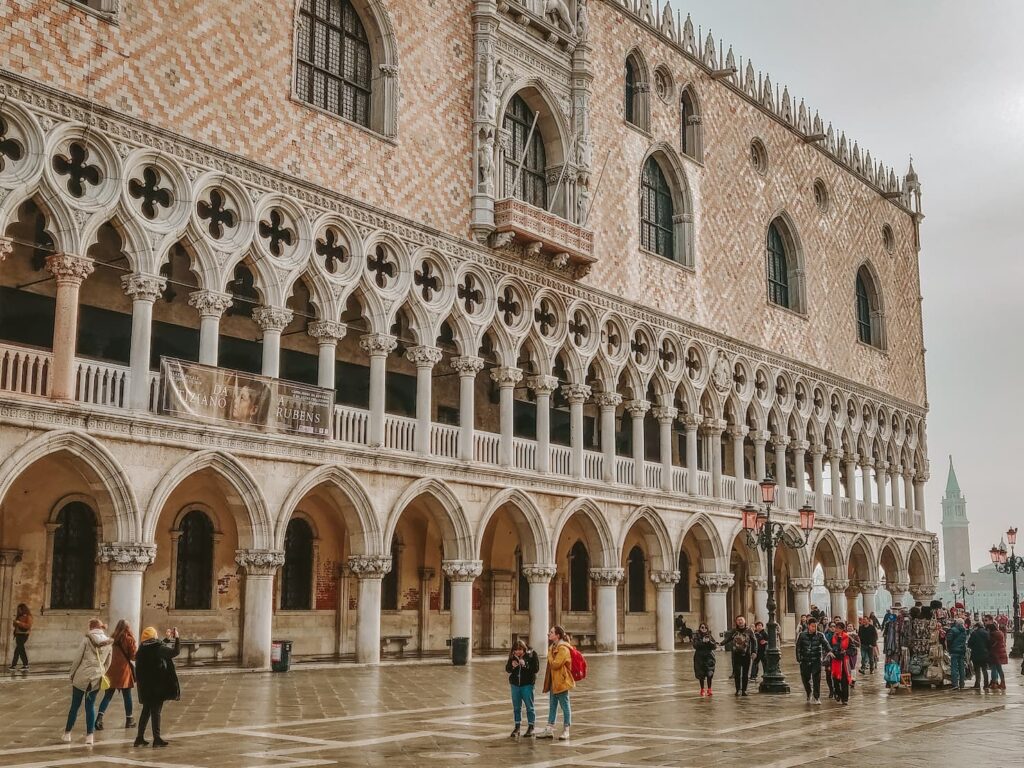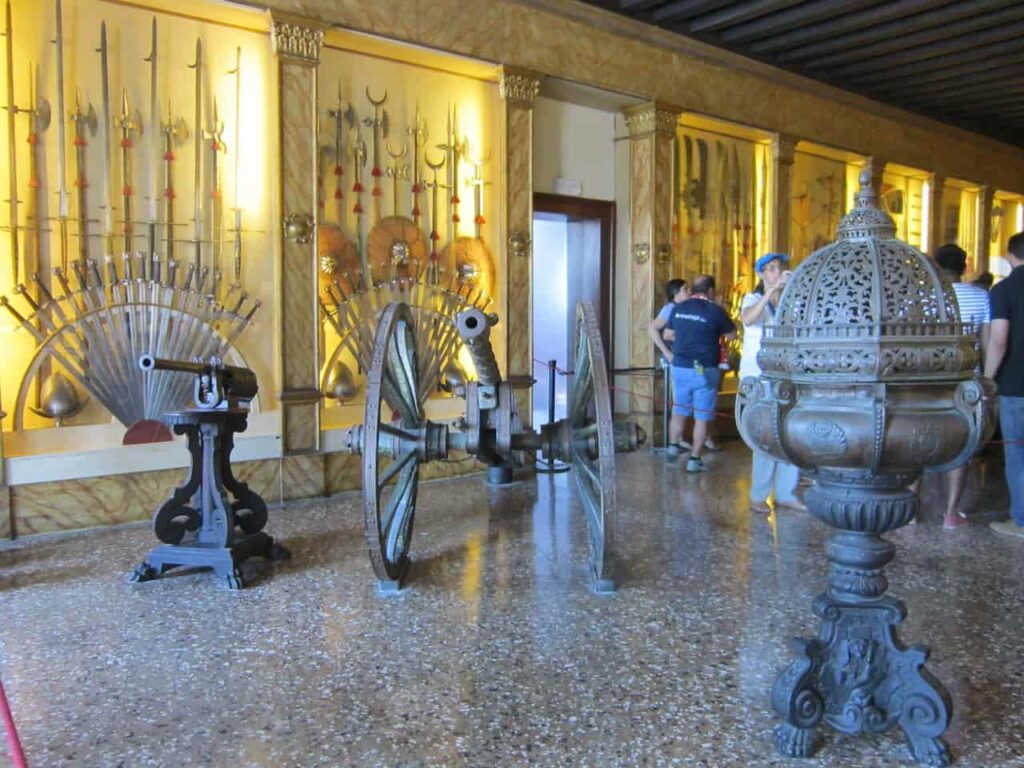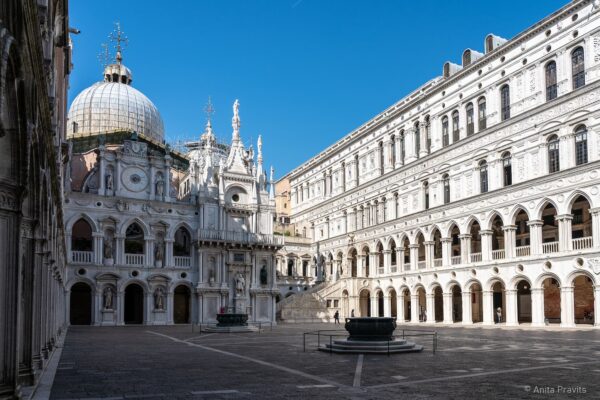The Armoury is one of the most characteristic rooms of the Doge’s Palace in Venice, and one of the most visited in the entire building.
It houses over two thousand weapons, shields, banners, and other war relics, which can be visited during a tour of the Doges’ Palace.
If you want to learn more about the history, architecture, and objects inside, read on.
Before we begin, a brief preamble: if you plan to visit the Doge’s Palace in Venice, the Armoury Rooms and all the other rooms, it is strongly recommended to buy your ticket online, to avoid the long queue that may form at the ticket office. By purchasing your ticket in advance, you will be able to enter the Palace skipping the queue.

Skip-the-line ticket Doge’s Palace Venice: Quick access
Buy online. Choose the time you prefer. Visit the Doge’s Palace in Venice, the Hall of the Great Council, the prisons and much more.
You can cancel for free up to the day before your visit.
Table of content
Armoury of the Doge’s Palace in Venice

The Armoury is the room in the Doge’s Palace dedicated to weapons, which were kept, from the 14th century onwards, in this warehouse that was initially under the control of the Great Council.
The entrance lock and many other components have the initials ‘CX’, indicating that they belonged to the Council of Ten, which was later assigned the management of these spaces.
The armoury housed not only shields, turquoises, and armaments, but also other types of memorabilia, such as war paraphernalia, trophies, banners, cloth, sculptures, and paintings donated to the State.
The armoury also played a representative role and was only opened to the public when Henry III visited Venice.
The rooms of the Armoury of the Doge’s Palace in Venice
The collection has four rooms and includes over two thousand weapons of various forms and uses.
Hall I (Sala del Gattamelata)
Hall I, called ‘del Gattamelata’ because of the armor belonging to the condottiere Erasmo da Narni, called Gattamelata, houses examples of sixteenth-century steeds, which were ridden in fights and tournaments. Also on display in the room are models of swords from different epochs, models of crossbows with the typical painted or molded leather turquoises for housing the arrows, and lanterns from Turkish ships snatched from the enemy, with the characteristic crescent moon on top.
Hall II
Hall II houses a triangular Turkish standard, won at the famous Battle of Lepanto in 1571. In the center it bears an inscription paying homage to Allah and his prophet Muhammad, with a border on which verses from the Koran have been embroidered. Worthy of note is the armor that was donated to the Republic in 1604 by Henry IV of France. Also in the room are two richly decorated fire halberds, several large broadswords, and a horse’s head armor from the 15th century.
Hall III
Hall III is named after the bust of Francesco Morosini, which is located in a niche at the back. During the war against the Turks from 1684 to 1688, the admiral was appointed supreme commander of the Venetian fleet and received the honorary nickname Peloponnesian. In 1688 he became doge. His many victories brought him the honor of a living monument, an exception in Venetian history. A large number of swords, halberds, quivers, and crossbows, which often have the initials CX engraved or painted on them, are collected and ordered in this room. To exemplify the power of the Council of Ten, the same initials also appear on the door jambs. The colubrina, a small, richly decorated mid-16th century cannon and 17th century arquebus with twenty barrels, ten longer and ten shorter, a true ancestor of the machine gun.
Hall IV
Hall IV contains a collection of weapons of different types: fire crossbows, fire maces, axes and fire swords from the 16th century and arquebuses from the 17th century. Curious is the so-called ‘devil’s box’, a trap that conceals a poisoned arrow, four gun barrels that explode when opened and a trap. In this room are torture instruments, a chastity belt and a variety of weapons that were forbidden due to their small size, which made them easy to hide. These were owned by the Carrara family of Padua, exterminated by the Venetians in 1405.
Armoury Venice: conclusions
Here we have come to the end of this post on the Armoury of the Doge’s Palace in Venice, in which we have seen together what this exhibition area was used for, what the different arms rooms are and what to visit inside the different spaces.
If you have any doubts or questions, read the article about the interior of the Doge’s Palace in Venice and the Chamber of the Great Council (the most famous room in the whole building), or leave a comment below. We will be happy to answer you!

Skip-the-line ticket Doge’s Palace Venice: Quick access
Buy online. Choose the time you prefer. Visit the Doge’s Palace in Venice, the Hall of the Great Council, the prisons and much more.
You can cancel for free up to the day before your visit.
Photo credits:
- Armeria: Foto di Shay Tressa DeSimone via Flickr


